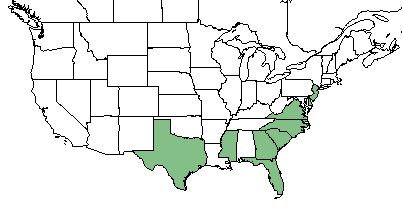Difference between revisions of "Cirsium virginianum"
(→Description) |
(→Distribution) |
||
| Line 27: | Line 27: | ||
==Distribution== | ==Distribution== | ||
| + | ''C. virginianum'' can be found in the Southeast United States, ranging from Texas to New Jersey, but excluding Louisiana and Alabama <ref name= "USDA"/>. | ||
| + | |||
==Ecology== | ==Ecology== | ||
===Habitat=== <!--Natural communities, human disturbed habitats, topography, hydrology, soils, light, fire regime requirements for removal of competition, etc.--> | ===Habitat=== <!--Natural communities, human disturbed habitats, topography, hydrology, soils, light, fire regime requirements for removal of competition, etc.--> | ||
Revision as of 12:36, 22 May 2018
| Cirsium virginianum | |
|---|---|

| |
| Photo by the Southeastern Flora Plant Database | |
| Scientific classification | |
| Kingdom: | Plantae |
| Division: | Magnoliophyta - Flowering plants |
| Class: | Magnoliopsida - Dicots |
| Order: | Asterales |
| Family: | Asteraceae |
| Genus: | Cirsium |
| Species: | C. virginianum |
| Binomial name | |
| Cirsium virginianum L | |

| |
| Natural range of Cirsium virginianum from USDA NRCS Plants Database. | |
Contents
Taxonomic Notes
Synonyms: Carduus virginianus Linnaeus, Cirsium revolutum (Small) Petrak
Varieties: none
Description
C. virginianum is a native biennial forb in the Asteraceae family [1].
Distribution
C. virginianum can be found in the Southeast United States, ranging from Texas to New Jersey, but excluding Louisiana and Alabama [1].
Ecology
Habitat
Conservation and Management
Cultivation and restoration
Photo Gallery
References and notes
- ↑ 1.0 1.1 USDA Plants Database URL: https://plants.usda.gov/core/profile?symbol=CIVI